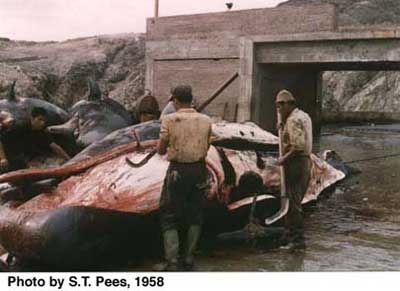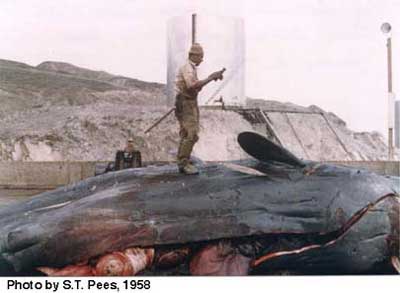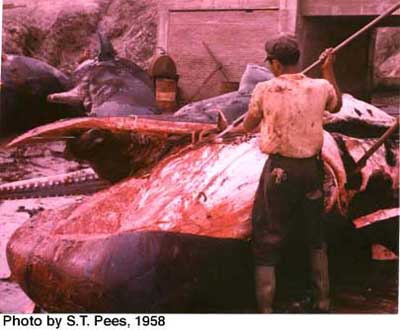 |
||||||
Cia. Ballenera del Norte S.A.
In 1957 the author visited a newly built shore station on the northern Peruvian coast near the small port of Paita. The location is fairly near to the line grounds of the whalers. The line refers to a hunting area along the equator which has been traditional since the late 1800's. The cold, fish and squid-laden Humboldt Current passes within hunting distance of the station and is a favored area of the sperm whales as well as the whalers. The station was built for rendering sperm oil. The principals were a Minnesota company together with Peruvian interests.
The station looked something like a small crude oil refinery. On the floor below the flensing deck there was a maze of vats and pipes. These were the try-pots (cookers), decanters, centrifuge and dehydrators. There were big tanks on the hillside to hold the sperm whale oil and two plants that purified sea water for the boilers of the station although some water was saved from the whales and used. Even steam from the several winches were recovered. The station, being in the Sechura Desert, tried drilling wells for fresh water, but they were dry.
When I was there the catcher boats had deposited their sperm whales in the sea near the ramp to the flensing deck. A hoist drew the whales up the ramp in their turn. The flensing was carried out by a Peruvian crew who, besides their special, extra sharp, curved knives on long handles, had the assistance of winches and cables to strip off the thick layer of blubber. The cut parts of the sperm whale were pushed into one or the other of three holes in the deck which led to the assigned cookers. In this operation the oil obtained from the head and the blubber was mixed together and considered to be of first quality. The remaining bones and tissue went through desludgers and were dehydrated. Some oil of second quality comes from this procedure and was sold locally for manufacturing soap. The whale meal was sold for animal feed fortifier (Rose, 1957).
The flensing deck was locally called the "plataforma de sacrificio", a morbid name but accurate. I had mixed emotions watching the skilled butchering of these giant mammals. The slop and blood on the deck was in great contrast to the neatly clean cookers and processing plant one floor below.
I learned a lot about the uses of first quality sperm oil in conversation with the engineer at this installation. The oil was sent to the U.S. where it was further refined in Ashtabula, Ohio, and in other plants.
The catch of the fishery of the Cia. Ballenera del Norte S.A. at that time (1958) was under the supervision of the South Pacific Conference which was composed of Ecuadorian, Peruvian and Chilean representatives (Rose, 1957). The Conference determined the size and quantity of the catch.
|
||
|
||
|
![]()
| © 2004, Samuel T. Pees all rights reserved |
|


